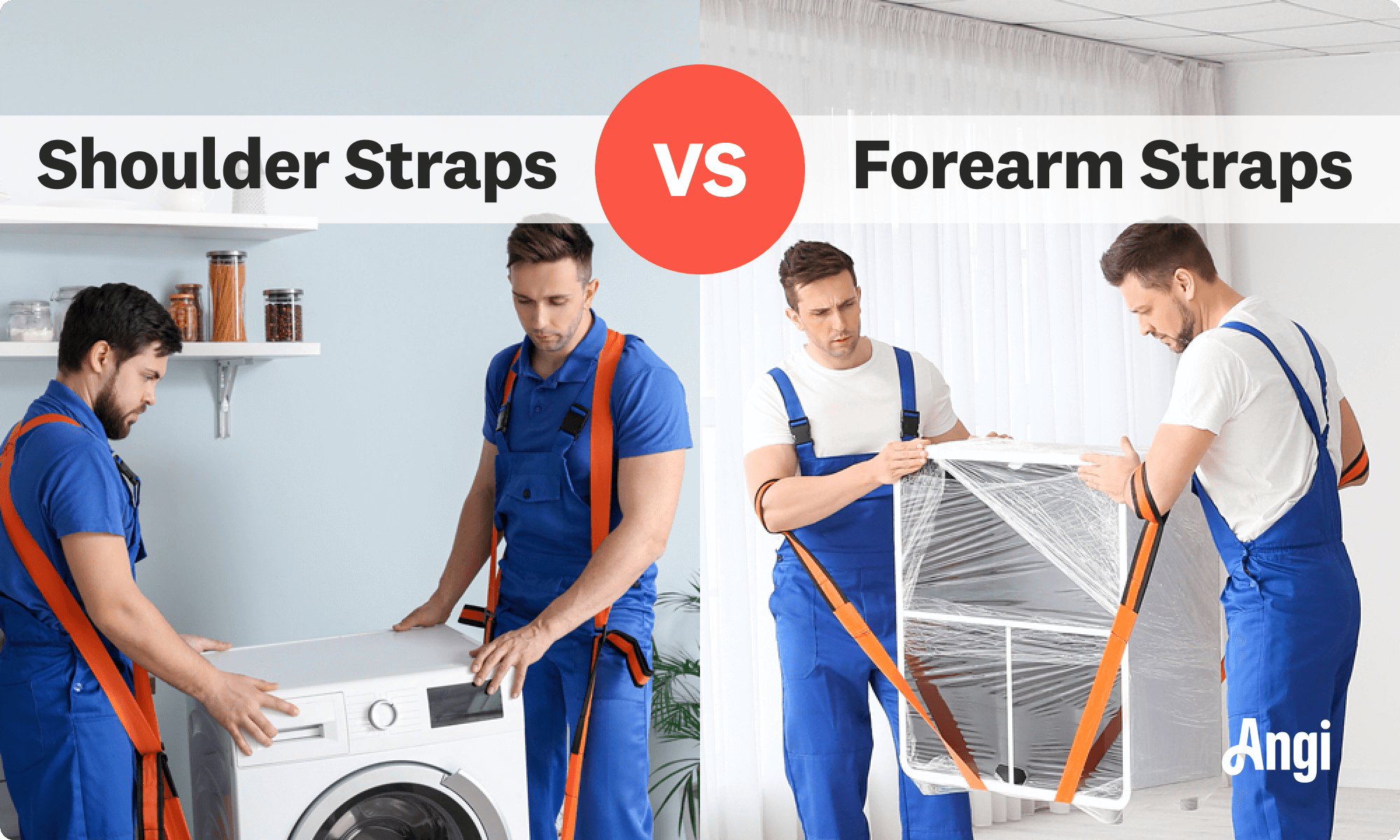
The cost range for renting a moving truck varies widely, so what can you expect to pay for your move? This cost guide breaks down all of the factors.
Use moving straps to give your back a break on moving day


Moving straps can help you move large or bulky pieces of furniture safely.
One or two people can use a moving strap.
Moving straps cost an average of $25 to $40, depending on the brand and model.
It’s no secret that moving furniture takes some preparation and elbow grease. Thankfully, learning how to use moving straps makes it easier, especially when transporting heavy or bulky items like a dresser, sofa, or a washing machine.
Moving straps can also save you from dropping large pieces of furniture, which could hurt you, your home, or the item. But before you grab a pair and start strapping them to yourself, learn how to effectively use them—your back will thank you for it.
It's important to move heavy furniture safely to avoid personal injury or property damage. The safest option is to hire professional movers with the right tools, equipment, and experience to move heavy furniture efficiently.

Moving straps, also known as furniture-lifting straps, are heavy-duty straps that help you move large or heavy pieces of furniture by distributing the weight of the objects more evenly. You can use a moving strap alone or with one other person.
These special straps slip underneath the object and attach to your shoulders, forearms, or both. This mechanism keeps you from bending over and makes carrying heavy things much easier, reducing the risk of personal injury.
There aren’t any hard and fast rules about when to use moving straps, so it’s smart to utilize them whenever you’re lifting something heavy. Moving straps help you avoid injury and lighten a heavy load, so you should consider using them to lift bulky furniture in most DIY moving scenarios.
Whether a room-to-room transfer or a DIY move across the country, moving straps offer safety and convenience, especially if you have stairs that a dolly or hand truck can’t navigate. On the other hand, if you can use a furniture dolly to relocate a bulky appliance or furniture piece, consider using that instead for increased efficiency and comfort.

Ready to try out your moving straps? Follow these guidelines for best results.
Just like any new piece of equipment, make sure to read the manufacturer's instructions on your moving straps before getting started. It’s imperative that you position the straps correctly and that you and your lifting partner know how to lift your object properly. Refer to the diagram that comes with the instructions and adjust them to be comfortable and not slip.
If possible, wear long sleeves and pants to cover as much skin as possible so that you don’t suffer any scrapes or irritation from the straps. You should also wear closed-toed shoes since sandals can be hazardous when caught in cracks or uneven surfaces.
Take measurements of not only the furniture you’re moving but also the entryways or rooms you plan to move them to ensure everything fits before you get to the heavy lifting. Once you’ve confirmed your measurements, map out your route either in your mind or with your fellow movers to make sure everyone’s on the same page.
Lay the lifting strap on the floor in front of the item you’re moving. The idea is to center the item onto the straps before you and your partner put them on.
Next, the moving team should tip the item back and forth to place it on top of (but toward the outside edge) your object. Slide the strap under it if needed. Repeat the same step on the other side if you’re using two straps.
The final step before take off is to ensure that the moving straps are in the middle of the object’s underside. This step is crucial to ensure the item’s weight is evenly distributed on both sides.
Once the item is ready for transport, place the straps across your chest and shoulders or forearms. If you are using two-person straps, make sure your partner straps in the same way.
Start moving slowly with your partner to lift the object at the same time. Once the item is in the air, communicate with your partner to take steps in tandem. Remember to vocalize when you need to take a break or run into any issues.
When you have the item where you want it, bend your knees, keep your back straight, and lower the item slowly to the ground.
Shoulder straps make moving heavy and awkward items, like a washing machine, easier. These moving devices have a harness that fits over your shoulders with a detachable and adjustable lifting strap. Plus, when using shoulder straps, your hands are entirely free to help steady the load.
Review the directions to fit the harness properly before starting the moving process. It's helpful to watch the manufacturer’s video if available. Pull the harness on like a shirt, with the X in the back and the lifting bar or buckle in front. The harness adjusts to accommodate various adult heights.
Center the lifting strap under the object. Then, each mover attaches the lifting strap to the harness by inserting it up and over the bar or buckle in a weaving motion. Adjust the lifting strap to gain at least 5 inches of lifting space off the ground. Tuck away the extra length of the lifting strap so you won’t trip.
Both moving partners should bend their knees with a straight back, stabilize the furniture with their hands, and slowly lift. Carefully walk the item to its final resting place and lower it to the ground. Then, each mover removes the lifting strap from the harness and removes it from underneath.
Forearm straps use your and your partner’s forearms’ strength instead of your shoulders. They’re best for lighter objects like moving a mattress or small furniture items.
Place two forearm moving straps under your furniture in an X. If the furniture doesn’t have legs to slip the straps under, you may need to tilt the piece. A forearm moving strap has a loop on each end, so next, thread each arm through one while your partner does the same on the opposite end of the furniture.
Now, each mover has one loop of each strap on their forearms. Some forearm straps have multiple loops to fit many peoples’ heights, so choose the one that feels best and allows you to lift the item at least 5 inches off the ground.
Your palms can guide the furniture while your forearms do the heavy lifting. When everything feels secure, bend your legs and lift the furniture at the same time as your partner. Then, carefully walk it to the next location and gently bend your knees to lower the object.
Remember to take these additional tips into account when using moving straps.
Wear closed-toe shoes: Make sure you wear heavy-duty close-toed shoes that aren’t slippery to avoid losing control of the object.
Clear the route: Figure out the best route to move your piece, and clear a path before you lift it. If you can eliminate putting it up and down or having to remove the straps to make room, that will save you time, frustration, and energy.
Always communicate: It’s essential to communicate with your partner about when you are going to lift and set down an item to prevent slippage or injuries.
Practice proper lifting techniques: Always lift with your legs and keep your back straight to reduce the risk of injuries.
The cost to hire professional movers depends mostly on how far you’re going, how much stuff you have, and your location. On average, a local move ranges from $880 to $2,570, while long-distance relocations can start at around $2,700 and go as high as $10,000 or more due to the extra mileage and logistics.
Moving straps are, by their nature, a DIY tool. You’ll use them to help move your own belongings with a family member or friend. Professional movers will bring their own moving straps as needed. If you purchase a new dolly or similar moving equipment for more frequent moves, it will often come with a set of moving straps of its own.
If you’d rather ditch the straps and hire a local moving company, you’ll pay more than the DIY cost. However, it’s well worth the cost if you’re moving multiple heavy items—that way, you can prevent personal injuries and ensure the move happens faster and safer.
From average costs to expert advice, get all the answers you need to get your job done.

The cost range for renting a moving truck varies widely, so what can you expect to pay for your move? This cost guide breaks down all of the factors.

Learn about storage unit cost based on the size, type, and features you need to safely keep your household and other possessions.

Wondering how much it costs to move your house to a new spot? Check out our helpful cost guide to learn how to budget for this major home project.

Moving long-distance means choosing what to bring and what to part with. Learn all the pros, cons, and costs of shipping versus buying new furniture when you move.

Our furnishing a new home checklist covers essential furniture for every room, and budgeting tips to create your perfect space without overspending.

Shed relocation without the hassle is possible; either to a different or new location. Discover the best professionals to safely and efficiently move your shed to its new home.